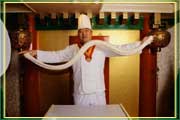The culinary student will have many opportunities to shine. However, before you become a cooking star you will want to consider these basic concepts in course work...
As a student in a culinary program, you will take courses in nutrition, sanitation, and even culinary history. You will study the properties of different ingredients, and learn how to plan a menu and create recipes based on both seasonal availability and a budget. You will also learn to effectively use different kitchen tools, especially knives, and then learn various cooking methods, such as braising and poaching, and making sauces, such as hollandaise and bechamel. You might study culinary preparation in terms of different regions, such as French and Asian cuisine, or in terms of types of food, such as soups and pastries.
A diploma or certificate typically takes anywhere between 8 and 18 months of full-time study after high school. An associate degree generally takes about two years and a bachelor's degree about four.
|
In a culinary program, you typically take courses such as the following:
- Baking and Patisserie
- Breakfast Foods
- Business Math
- Culinary Science
- Culinary Skills and Equipment Operation
- Dining Room Operations
- Fish and Shellfish
- Food Service and Kitchen Management
- Garde Manger (cold food preparation)
- International Cuisine
- Meat and Poultry
- Menu Planning
- Nutrition
- Plating and Presentation
- Purchasing and Cost Control
- Quantity Food Production
- Safety and Sanitation
- Sauces, Soups, and Stocks Wine and Wine Service
|
Many programs include an internship or practicum in their curriculum. This gives you the opportunity to practice what you have learned under the guidance and supervision of an experienced chef.
You might assist a chef in a restaurant owned by your culinary school, or you might work in an unaffiliated restaurant. Besides the real-world experience, an internship also exposes you to the different cooking styles of different chefs.
- Students are expected to purchase their own cooking tools and chef's uniform.
- If your program does not offer a practicum or internship, seek out an apprenticeship on your own. As mentioned above, a practicum gives you working experience and exposes you to different cooking styles. You also make professional contact with potential employers or references.
- A few different organizations offer certification as a culinary artist or chef. While certification is not required to be a chef, it does show potential employers your competence and knowledge of cooking.
- Every state has different regulations for food safety and preparation in institutions, such as restaurants. Check with your local health department or state restaurant association for more information on specific requirements. You may need to get a certificate in food safety before you can start working.
Contact a school to find out more about their requirements, since each curriculum is different. Good luck!
 
|









